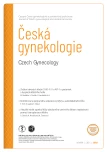Adverse events of PARP inhibitors
Authors:
Romanová M.; Klát J.
Authors place of work:
Gynekologicko-porodnická klinika FN Ostrava
Published in the journal:
Ceska Gynekol 2021; 86(1): 54-60
Category:
Přehledový článek
doi:
https://doi.org/10.48095/cccg202154
Summary
Objective: An evaluation of the safety of poly-ADP-ribose-polymerase inhibitors (PARPi) in ovarian cancer treatment.
Methods: An analysis of the studies on PARP inhibitors, a summary of the most common and serious adverse events.
Results: According to the studies, the most common adverse events of PARPi include hematotoxicity, nausea and vomiting. Serious adverse events leading to dose reduction or treatment interruption or termination include anemia, thrombocytopenia, nausea, fatigue and hypertension.
Conclusion: According to the results of the recent studies, the treatment of ovarian cancer with PARP inhibitors is generally safe.
Keywords:
ovarian cancer – PARP inhibitors – Adverse events – BRCA
Zdroje
1. Xue C, Xu Y, Gao H et al. Expression of PD-L1 in ovarian cancer and its synergistic antitumor effect with PARP inhibitor. Gynecol Oncol 2020; 157 (1): 222–233. doi: 10.1016/j.ygyno. 2019.12.012.
2. Chen Y, Du H. The promising PARP inhibitors in ovarian cancer therapy: from olaparib to others. Biomed Pharmacother 2018; 99: 552–560. doi: 10.1016/j.biopha.2018.01.094.
3. Zhong Y, Meng Y, Xu X et al. Design, synthesis and evaluation of phthalazinone thiohydantoin-based derivative as potent PARP-1 inhibitors. Bioorg Chem 2019; 91: 103181. doi: 10.1016/j.bioorg.2019.103181.
4. Herzog TJ, Armstrong DK. First-line chemotherapy for advanced (stage III or IV) epithelial ovarian, fallopian tubal, and peritoneal cancer. [online]. Available from: https: //www.uptodate.com/contents/first-line-chemotherapy-for-advanced-stage-iii-or-iv-epithelial-ovarian-fallopian-tube-and-peritoneal-cancer.
5. Klener P jr, Klener P. Principy systémové protinádorové léčby. Praha: Grada, 2013.
6. Zheng F, Zhang Y, Chen S et al. Mechanism and current progress of Poly ADP-ribose polymerase (PARP) inhibitors in the treatment of ovarian cancer, Biomed Pharmacother 2020; 123: 109661. doi: 10.1016/j.biopha.2019.109661.
7. Moore KM, Markham MJ. Management of ovarian cancer associated with BRCA and other genetic mutations. [online]. Available from: https: //www.uptodate.com/contents/management-of-ovarian-cancer-associated-with-brca-and-other-genetic-mutations.
8. Mateo J, Lord CJ, Serra V et al. A decade of clinical development of PARP inhibitors in perspective. Ann Oncol 2019; 30 (9): 1437–1447. doi: 10.1093/annonc/mdz192.
9. Wakefield MJ, Nesic K, Kondrashova O et al. Diverse mechanisms of PARP inhibitor resistance in ovarian cancer. Biochim Biophys Acta Rev Cancer 2019; 1872 (2): 188307. doi: 10.1016/j.bbcan.2019.08.002.
10. Hennes ER, Dow-Hillgartner EN, Bergsbaken JJ et al. PARP-inhibitor potpourri: a comparative review of class safety, efficacy, and cost. J Oncol Pharm Pract 2020; 26 (3): 718–729. doi: 10.1177/1078155219895066.
11. Madariaga A, Bowering V, Ahrari S et al. Manage wisely: poly (ADP-ribose) polymerase inhibitor (PARPi) treatment and adverse events. Int J Gynecol Cancer 2020; 30 (7): 903–915. doi: 10.1136/ijgc-2020-001288.
12. Gadducci A, Guerrieri MA. PARP inhibitors alone and in combination with other biological agents in homologous recombination deficient epithelial ovarian cancer: from the basic research to the clinic. Crit Rev Oncol Hematol 2017; 114: 153–165. doi: 10.1016/j.critrevonc.2017.04.006.
13. Penson RT, Villalobos RV, Cibula D et al. Olaparib versus nonplatinum chemotherapy in patients with platinum-sensitive relapsed ovarian cancer and germline BRCA1/2 mutation (SOLO3): a randomized phase III trial. J Clin Onkol 2020; 38 (11): 1164–1172. doi: 10.1200/JCO.19.02745.
14. Arora S, Balasubramaniam S, Zhang H et al. FDA approval summary: olaparib monotherapy or in combination with bevacizumab for the maintenance treatment of patients with advanced ovarian cancer. Oncologist 2021; 26 (1): e164–e172. doi: 10.1002/onco.13551.
15. Pothuri B, O’Cearbhaill R, Eskander R et al. Frontline PARP inhibitor maintenance therapy in ovarian cancer: a society of gynecologic oncology practice statement. Gynecol Oncol 2020; 159 (1): 8–12. doi: 10.1016/j.ygyno.2020.07.097.
16. Colombo N, Oza AM, Lorusso D et al. The effect of age on efficacy, safety and patient – centered outcomes with rucaparib: a post hoc exploratory analysis of ARIEL3, a phase 3, randomized, maintenance study in patients with recurrent ovarian carcinoma. Gynecol Oncol 2020; 159 (1): 101–111. doi: 10.1016/j.ygyno.2020.05.045.
17. González-Martín A, Pothuri B, Vergote I et al. Niraparib in patiens with newly diagnosed advanced ovarian cancer. N Engl J Med 2019; 381 (25): 2391–2401. doi: 10.1056/NEJMoa1910962.
18. Coleman RL, Fleming GF, Brady MF et al. Veliparib with first-line chemotherapy and as maintenance therapy in ovarian cancer. N Engl J Med 2019; 381 (25): 2403–2415. doi: 10.1056/NEJMoa1909707.
Štítky
Dětská gynekologie Gynekologie a porodnictví Reprodukční medicínaČlánek vyšel v časopise
Česká gynekologie

2021 Číslo 1
Nejčtenější v tomto čísle
- Nežádoucí účinky PARP inhibitorů
- Kombinovaná peripartálna separácia symfýzy a sakroiliakálneho kĺbu
- Aspekty výběru embryí a jejich příprava pro vznik lidských embryonálních kmenových buněk určených k humánní terapii
- Poruchy příjmu potravy v ambulanci gynekologa pro děti a dospívající
